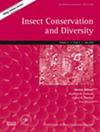苏里南和法属圭亚那不断变化的地貌在食土白蚁扩散中的作用
IF 3.2
2区 农林科学
Q1 ENTOMOLOGY
引用次数: 0
摘要
新热带森林生态系统拥有重要的生物多样性。要制定有效的昆虫保护措施,就必须了解影响物种多样性和种群结构的因素。白蚁的扩散是种群结构的一个关键决定因素,对在木材中筑巢的白蚁或生活在城市环境中的白蚁的扩散研究较多,因为扩散可能受到木材运输的影响。然而,对于流动性不受木材运输影响的白蚁的扩散,研究仍然不足。我们研究了Embiratermes neotenicus的扩散情况,它是一种以土壤为食的白蚁,扩散距离很短,在新热带地区,既有完整的森林,也有退化的森林。利用线粒体和核数据,我们对苏里南和法属圭亚那 70 个群落的遗传多样性、结构和导致种群分化的因素进行了多尺度分析。法属圭亚那的种群是该地区的祖先种群,后来扩大了。在苏里南和法属圭亚那观察到了种群间的显著遗传分化,并发现了不同的模式。苏里南种群显示出较高的遗传多样性,没有亚种群分化,而法属圭亚那种群则显示出不同遗传群的亚结构。对所有群落规模的分析表明,景观特征(如马罗尼河)对遗传分化有影响。在局部范围内,随着森林的改变,即使森林覆盖率没有发生重大变化,群落间的遗传分化也会增加。我们的研究结果凸显了土食白蚁种群对栖息地变化的敏感性。我们认为,需要进行多尺度研究,以全面了解遗传模式,特别是对于散布距离较短的物种。本文章由计算机程序翻译,如有差异,请以英文原文为准。


The role of changing landscape in the dispersal of a soil-feeding termite in Suriname and French Guiana
求助全文
通过发布文献求助,成功后即可免费获取论文全文。
去求助
来源期刊
CiteScore
7.70
自引率
8.60%
发文量
58
审稿时长
>12 weeks
期刊介绍:
To publish papers of the highest scientific quality within the general area of insect (and other arthropods) conservation and diversity covering topics ranging from ecological theory to practical management.
Papers are invited on the following topics: Conservation genetics; Extinction debt; Long-term conservation planning and implementation; Global implications of local or national conservation actions; Management responses of species and communities; Captive breeding programs; Comparisons of restored and natural habitats; Biogeography; Global biodiversity; Metapopulation dynamics; Climate change: impacts on distributions and range; Invasive species: impacts and control; Effects of pollution; Genetic threats to diversity by introgression; Effects of fragmentation on diversity and distribution; Impact of agricultural and forestry practices on biodiversity; Enhancing urban environments for diversity and protection; Biodiversity action plans: can we scale up from insects?; Effectiveness and choice of indicator species; Soil biodiversity and interactions with above-ground biodiversity; Ecological interactions at local levels; Ecological and evolutionary factors influencing diversity and local, regional and global scales; Sustainable livelihoods and training on the ground; Integrating science and policy.

 求助内容:
求助内容: 应助结果提醒方式:
应助结果提醒方式:


